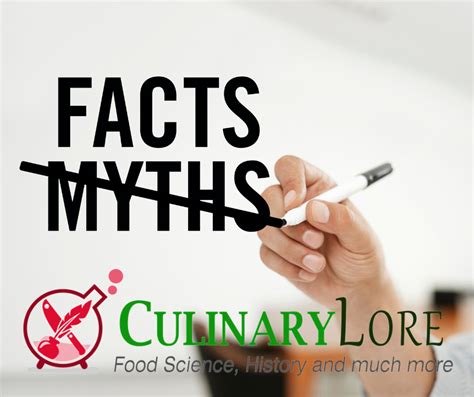
Many common cooking beliefs, such as searing meat to seal in juices or that rinsing pasta after cooking is always necessary, are misconceptions debunked by experienced cooks and food experts. These myths, often passed down through generations, can hinder culinary creativity and lead to suboptimal results in the kitchen.
A plethora of widely held cooking myths continue to circulate in home and professional kitchens, often leading to unnecessary steps, wasted effort, and even compromised flavors. These misconceptions, perpetuated through tradition and anecdotal evidence, are now being challenged by chefs, food scientists, and avid home cooks who leverage modern culinary understanding and experimentation. From the proper way to cook pasta to the ideal method for searing meat, many established “rules” are proving to be more fiction than fact.
Common Culinary Myths Debunked
Several pervasive cooking myths have been identified and debunked, offering cooks a chance to refine their techniques and achieve better results. Let’s delve into some of the most common examples.
-
Searing Meat Seals in Juices: This is perhaps one of the most enduring cooking myths. The belief is that searing meat at high temperatures creates a crust that prevents juices from escaping during cooking, resulting in a more flavorful and succulent final product. However, this is not the case. According to culinary science, searing meat does not create an impenetrable barrier. “Searing meat doesn’t actually seal in the juices,” confirms numerous food experts. Instead, searing enhances flavor through the Maillard reaction, a chemical process between amino acids and reducing sugars that creates complex and desirable flavors and aromas. While searing does contribute significantly to the overall taste of the meat, it doesn’t prevent moisture loss. In fact, searing can sometimes cause the meat to expel moisture, especially if the pan is not hot enough or the meat is overcrowded. The key to retaining moisture in cooked meat lies in proper cooking temperature control, avoiding overcooking, and allowing the meat to rest after cooking.
-
Rinsing Pasta After Cooking is Always Necessary: Another common belief is that rinsing pasta after cooking is essential to prevent it from sticking together. While this may be true in certain situations, it’s not a universal rule. Rinsing pasta removes the starch that coats the noodles. This starch is crucial for helping sauce adhere to the pasta, creating a cohesive and flavorful dish. Therefore, rinsing is generally only recommended when making cold pasta salads or when using the pasta in a dish where you don’t want the sauce to cling to it. For hot pasta dishes, such as spaghetti with marinara sauce or fettuccine Alfredo, rinsing is best avoided. The starchy water can even be reserved and added to the sauce to thicken it and enhance its flavor.
-
Adding Oil to Pasta Water Prevents Sticking: The idea that adding oil to pasta water will prevent the pasta from sticking together is another myth. Oil and water are immiscible, meaning they don’t mix. The oil will simply float on the surface of the water and won’t effectively coat the pasta. While a thin layer of oil might theoretically coat the pasta as it’s being drained, it’s not an efficient or effective way to prevent sticking. The best way to prevent pasta from sticking is to use a large pot of boiling water, stir the pasta frequently during the first few minutes of cooking, and avoid overcooking it. Overcooked pasta releases more starch, which contributes to stickiness.
-
You Must Knead Dough for 10-15 Minutes: Traditional baking wisdom often dictates that kneading dough for an extended period, typically 10-15 minutes, is necessary to develop gluten and achieve the desired texture. While kneading is indeed crucial for gluten development in many bread recipes, the required kneading time can vary significantly depending on the type of dough, the flour used, and the mixing method. Over-kneading can actually result in a tough and dense bread. Modern stand mixers and food processors can significantly reduce kneading time, and some no-knead bread recipes require minimal or no kneading at all. The key is to understand the properties of the dough and adjust the kneading time accordingly.
-
Using a Dull Knife is Safer Than a Sharp Knife: This might seem counterintuitive, but a sharp knife is actually safer to use than a dull knife. A dull knife requires more force to cut through food, increasing the likelihood of slipping and causing an injury. A sharp knife, on the other hand, cuts cleanly and effortlessly, giving you more control and reducing the risk of accidents. It is important to maintain sharp knives and use proper cutting techniques.
-
Mushrooms Should Not Be Washed: While it’s true that mushrooms can absorb water, washing them briefly under cool water is perfectly fine and often necessary to remove dirt and debris. The key is to wash them just before cooking and avoid soaking them for extended periods. Alternatively, you can clean mushrooms with a damp cloth or brush.
-
Putting Knives in the Dishwasher is Okay: The high heat and harsh detergents in dishwashers can damage knives, dulling their blades and corroding their handles. It’s always best to wash knives by hand with warm, soapy water and dry them immediately.
-
Always Refrigerate Eggs: In many countries, including the United States, eggs are typically refrigerated due to regulations regarding the washing process, which removes a protective layer on the shell. However, in some European countries, where eggs are not washed in the same way, refrigeration is not always necessary. It’s important to follow local food safety guidelines regarding egg storage.
-
Microwaving Food Destroys Nutrients: Microwaving, like any cooking method, can cause some nutrient loss. However, it generally preserves nutrients better than boiling, which leaches nutrients into the water. The key is to microwave food for the shortest time possible and use minimal water.
-
Salt Should Be Added to Water Before Boiling: While salting pasta water is important for flavoring the pasta itself, adding salt before the water boils doesn’t significantly affect the boiling time. Salt does raise the boiling point of water, but the amount of salt typically added to pasta water has a negligible effect on the boiling time.
The Importance of Critical Thinking in the Kitchen
Debunking these common cooking myths highlights the importance of critical thinking and a willingness to question established practices in the kitchen. Instead of blindly following recipes or relying on outdated information, cooks should strive to understand the science behind cooking and experiment with different techniques to find what works best for them.
“Questioning these myths is not just about correcting errors; it’s about empowering cooks to understand why they’re doing what they’re doing,” explains a food science expert. This deeper understanding can lead to more creative and confident cooking, as well as better results.
The Role of Science in Culinary Arts
The rise of culinary science has played a significant role in debunking many cooking myths. By applying scientific principles to cooking, chefs and food scientists have been able to explain why certain techniques work and others don’t. This has led to a more evidence-based approach to cooking, where decisions are based on data and experimentation rather than tradition or hearsay.
Molecular gastronomy, a subdiscipline of food science, has been particularly influential in challenging conventional cooking wisdom. By exploring the chemical and physical properties of food, molecular gastronomy has revealed new ways to manipulate ingredients and create innovative dishes.
Impact on Modern Cooking
The debunking of cooking myths has had a significant impact on modern cooking. Chefs are now more willing to experiment with new techniques and ingredients, and home cooks are becoming more informed and empowered in the kitchen. This has led to a more dynamic and creative culinary landscape, where innovation and experimentation are encouraged.
“The internet has democratized culinary knowledge,” notes a prominent food blogger. “Now, anyone can access information about cooking techniques and ingredients, and learn from chefs and food scientists around the world.”
Frequently Asked Questions (FAQs)
1. Does searing meat truly seal in the juices, and if not, what is its real purpose?
No, searing meat does not create an impenetrable barrier to seal in juices. The primary purpose of searing is to develop flavor through the Maillard reaction, a chemical process that occurs when amino acids and reducing sugars react at high temperatures. This reaction creates complex and desirable flavors and aromas, enhancing the overall taste of the meat. Searing does not prevent moisture loss, and proper cooking temperature control and resting the meat after cooking are more effective methods for retaining moisture.
2. Is it always necessary to rinse pasta after cooking, and when is it appropriate to skip this step?
Rinsing pasta after cooking is not always necessary. It’s only recommended when making cold pasta salads or when using the pasta in a dish where you don’t want the sauce to cling to it. Rinsing removes the starch that helps sauce adhere to the pasta. For hot pasta dishes, avoid rinsing to allow the sauce to bind properly. The starchy water can even be reserved to thicken the sauce.
3. How can I prevent pasta from sticking together without adding oil to the water?
To prevent pasta from sticking together, use a large pot of boiling water, stir the pasta frequently during the first few minutes of cooking, and avoid overcooking it. Overcooked pasta releases more starch, contributing to stickiness. Adding oil to the water is ineffective as oil and water do not mix.
4. Is a sharp knife really safer than a dull one, and why?
Yes, a sharp knife is safer than a dull knife. A dull knife requires more force to cut through food, increasing the likelihood of slipping and causing injury. A sharp knife cuts cleanly and effortlessly, providing more control and reducing the risk of accidents.
5. Does microwaving food destroy nutrients, and what are some ways to minimize nutrient loss when using a microwave?
Microwaving food can cause some nutrient loss, like any cooking method. However, it generally preserves nutrients better than boiling, which leaches nutrients into the water. To minimize nutrient loss, microwave food for the shortest time possible and use minimal water.
Detailed Breakdown of the Article Content
The article delves into several specific cooking myths, providing a detailed explanation of each one and debunking them with scientific evidence and expert opinions.
Searing Meat: The myth that searing meat seals in juices is thoroughly addressed, explaining that searing primarily enhances flavor through the Maillard reaction rather than preventing moisture loss. The article highlights the importance of proper cooking temperature control and resting the meat after cooking to retain moisture.
Rinsing Pasta: The article clarifies the circumstances under which rinsing pasta is appropriate, distinguishing between hot and cold pasta dishes. It explains that rinsing removes starch, which is crucial for sauce adhesion in hot dishes, while it may be desirable in cold salads to prevent stickiness.
Adding Oil to Pasta Water: The article explains why adding oil to pasta water is ineffective, as oil and water do not mix. It provides alternative methods for preventing pasta from sticking, such as using a large pot of boiling water and stirring frequently.
Kneading Dough: The article challenges the traditional belief that kneading dough for an extended period is always necessary. It explains that the required kneading time can vary depending on the type of dough, flour, and mixing method, and that over-kneading can be detrimental.
Knife Safety: The article dispels the misconception that a dull knife is safer than a sharp knife, emphasizing the importance of using sharp knives for better control and reduced risk of injury.
Mushroom Washing: The article addresses the concern that washing mushrooms will make them soggy, clarifying that briefly washing them under cool water is fine for removing dirt and debris, as long as they are not soaked for extended periods.
Dishwasher and Knives: The article recommends hand-washing knives instead of putting them in the dishwasher to prevent damage to the blades and handles.
Egg Refrigeration: The article explains the differences in egg storage practices between countries, depending on whether the eggs are washed or not.
Microwaving Nutrients: The article clarifies that microwaving does not necessarily destroy nutrients and can be a better option than boiling for preserving them.
Salting Water: The article states adding salt to water before boiling doesn’t affect boiling time.
The Importance of Critical Thinking: The article emphasizes the importance of critical thinking and questioning established practices in the kitchen, encouraging cooks to understand the science behind cooking and experiment with different techniques.
The Role of Science: The article highlights the role of culinary science and molecular gastronomy in debunking cooking myths and providing a more evidence-based approach to cooking.
Impact on Modern Cooking: The article discusses the impact of debunking myths on modern cooking, leading to more experimentation, innovation, and informed cooking practices.
Expanded Context and Analysis
The debunking of cooking myths is not merely a matter of correcting isolated errors; it represents a broader shift towards a more informed and scientific approach to culinary arts. This shift is driven by several factors, including the increasing availability of culinary education, the rise of food science as a recognized discipline, and the democratization of culinary knowledge through the internet.
Culinary Education and Professionalization:
Formal culinary education has become more accessible, with numerous culinary schools and programs offering comprehensive training in cooking techniques, food science, and restaurant management. These programs emphasize the importance of understanding the scientific principles behind cooking, enabling chefs to make informed decisions and troubleshoot problems in the kitchen.
As the culinary profession becomes more professionalized, there is a greater emphasis on evidence-based practices and continuous learning. Chefs are encouraged to stay up-to-date with the latest research and techniques, and to challenge traditional practices that are not supported by scientific evidence.
The Rise of Food Science:
Food science has emerged as a distinct discipline that applies scientific principles to the study of food. Food scientists investigate the chemical, physical, and biological properties of food, and develop new methods for processing, preserving, and preparing food.
Food science research has played a crucial role in debunking cooking myths by providing scientific explanations for why certain techniques work and others don’t. For example, food scientists have conducted studies on the Maillard reaction to understand how it contributes to flavor development, and on the effects of different cooking methods on nutrient retention.
Democratization of Culinary Knowledge:
The internet has revolutionized the way people access and share culinary knowledge. Online resources, such as food blogs, cooking websites, and video tutorials, have made it easier for home cooks to learn about cooking techniques and ingredients.
The internet has also facilitated communication and collaboration among chefs, food scientists, and home cooks. Online forums and social media platforms provide opportunities for people to share their experiences, ask questions, and learn from each other.
This democratization of culinary knowledge has empowered home cooks to become more informed and experimental in the kitchen. They are no longer reliant on traditional recipes and outdated advice, but can access a wealth of information and resources to guide their cooking decisions.
The Future of Culinary Arts:
The debunking of cooking myths is an ongoing process, as new research and discoveries continue to challenge conventional wisdom. As culinary arts evolves, it is likely to become even more interdisciplinary, integrating insights from food science, nutrition, psychology, and other fields.
Chefs and food scientists will continue to collaborate to develop new and innovative cooking techniques that are both delicious and nutritious. They will also focus on creating more sustainable and ethical food systems, addressing issues such as food waste, environmental impact, and animal welfare.
In the future, cooking will be less about blindly following recipes and more about understanding the science behind food and applying that knowledge to create personalized and satisfying culinary experiences.
Specific Examples of Debunked Myths in Detail
Let’s examine a few of the debunked myths in more detail, providing a more in-depth analysis of the scientific principles involved.
Searing Meat and the Maillard Reaction:
As mentioned, searing meat does not seal in juices. The primary benefit of searing is the Maillard reaction. This is a complex chemical reaction that occurs between amino acids and reducing sugars at high temperatures, typically between 280°F and 330°F (140°C and 165°C).
The Maillard reaction produces hundreds of different flavor compounds, which contribute to the characteristic aroma and taste of browned meat. The specific flavor compounds that are formed depend on the temperature, the type of amino acids and sugars present, and the cooking time.
While searing enhances flavor, it does not prevent moisture loss. Meat is composed of approximately 75% water, and some of that water will inevitably evaporate during cooking. To minimize moisture loss, it’s important to cook the meat at a moderate temperature and avoid overcooking it. Resting the meat after cooking allows the muscle fibers to relax and reabsorb some of the moisture.
Rinsing Pasta and Starch Gelatinization:
Pasta is made from wheat flour, which is primarily composed of starch. When pasta is cooked in boiling water, the starch granules absorb water and swell, a process known as gelatinization.
The gelatinized starch creates a sticky coating on the surface of the pasta. This coating is desirable when making hot pasta dishes, as it helps the sauce adhere to the pasta. However, it can be undesirable when making cold pasta salads, as it can cause the pasta to clump together.
Rinsing pasta after cooking removes the gelatinized starch, preventing it from sticking together. However, it also removes the starch that helps the sauce adhere to the pasta. Therefore, rinsing is only recommended when making cold pasta salads or when using the pasta in a dish where you don’t want the sauce to cling to it.
The Dull Knife Danger:
The safety of using a sharp knife versus a dull knife is often misunderstood. A sharp knife, maintained properly, requires less pressure to cut through food. This reduces the likelihood of the knife slipping and causing an accident. A dull knife, on the other hand, requires significantly more force, increasing the risk of the knife slipping and causing a serious injury. Furthermore, the ragged edges created by a dull knife can cause more tissue damage, leading to a slower and more painful healing process. Proper knife skills and regular sharpening are essential for safe food preparation.
Impact on Professional Chefs
For professional chefs, debunking cooking myths and embracing a science-based approach is not merely a matter of curiosity but a necessity for innovation and excellence. Chefs are increasingly expected to understand the chemical and physical transformations that occur during cooking and to use that knowledge to create dishes that are both delicious and visually appealing.
Molecular gastronomy techniques, such as spherification, sous vide cooking, and the use of hydrocolloids, have become increasingly popular in fine dining restaurants. These techniques require a deep understanding of food science and a willingness to experiment with new ingredients and methods.
Chefs are also increasingly focused on sustainability and ethical sourcing, and they are using their knowledge of food science to develop innovative ways to reduce food waste and minimize their environmental impact.
Conclusion
The debunking of cooking myths represents a significant shift in the culinary world, driven by the rise of culinary education, the emergence of food science, and the democratization of culinary knowledge through the internet. By questioning established practices and embracing a more scientific approach to cooking, chefs and home cooks can improve their techniques, create more innovative dishes, and make more informed decisions about food. This ongoing process of learning and experimentation is essential for the continued evolution of culinary arts and the pursuit of culinary excellence.









